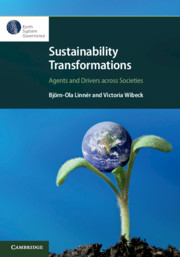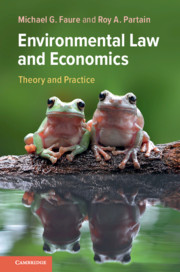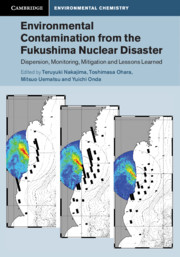Refine listing
Actions for selected content:
2285 results in Ebooks in ecology and environment
Abbreviations
-
- Book:
- Sustainability Transformations
- Published online:
- 27 September 2019
- Print publication:
- 03 October 2019, pp xvii-xviii
-
- Chapter
- Export citation
5 - Localising Transformations
- from Part II - Varieties of Transformations to Sustainability
-
- Book:
- Sustainability Transformations
- Published online:
- 27 September 2019
- Print publication:
- 03 October 2019, pp 94-122
-
- Chapter
- Export citation
Reviews
-
- Book:
- Food or War
- Published online:
- 23 August 2019
- Print publication:
- 03 October 2019, pp ii-iv
-
- Chapter
- Export citation
5 - Hotspots for Food Conflict in the Twentyfirst Century
-
- Book:
- Food or War
- Published online:
- 23 August 2019
- Print publication:
- 03 October 2019, pp 125-173
-
- Chapter
- Export citation
Part II - Varieties of Transformations to Sustainability
-
- Book:
- Sustainability Transformations
- Published online:
- 27 September 2019
- Print publication:
- 03 October 2019, pp 61-144
-
- Chapter
- Export citation

Sustainability Transformations
- Agents and Drivers across Societies
-
- Published online:
- 27 September 2019
- Print publication:
- 03 October 2019

Environmental Law and Economics
- Theory and Practice
-
- Published online:
- 13 September 2019
- Print publication:
- 10 October 2019

Food or War
-
- Published online:
- 23 August 2019
- Print publication:
- 03 October 2019

Environmental Contamination from the Fukushima Nuclear Disaster
- Dispersion, Monitoring, Mitigation and Lessons Learned
-
- Published online:
- 16 August 2019
- Print publication:
- 15 August 2019
1 - Introduction
- from Part I - Transport of Radioactive Materials in the Environment
-
- Book:
- Environmental Contamination from the Fukushima Nuclear Disaster
- Published online:
- 16 August 2019
- Print publication:
- 15 August 2019, pp 5-49
-
- Chapter
- Export citation
Preface
-
- Book:
- Environmental Contamination from the Fukushima Nuclear Disaster
- Published online:
- 16 August 2019
- Print publication:
- 15 August 2019, pp xix-xxi
-
- Chapter
- Export citation
Names of Locations
-
- Book:
- Environmental Contamination from the Fukushima Nuclear Disaster
- Published online:
- 16 August 2019
- Print publication:
- 15 August 2019, pp 351-352
-
- Chapter
- Export citation
7 - Monitoring System
- from Part II - Development and Future Issues for the Infrastructure of Disaster Prevention
-
- Book:
- Environmental Contamination from the Fukushima Nuclear Disaster
- Published online:
- 16 August 2019
- Print publication:
- 15 August 2019, pp 219-229
-
- Chapter
- Export citation
Index
-
- Book:
- Environmental Contamination from the Fukushima Nuclear Disaster
- Published online:
- 16 August 2019
- Print publication:
- 15 August 2019, pp 353-356
-
- Chapter
- Export citation
5 - Ocean Transport of Radioactive Materials
- from Part I - Transport of Radioactive Materials in the Environment
-
- Book:
- Environmental Contamination from the Fukushima Nuclear Disaster
- Published online:
- 16 August 2019
- Print publication:
- 15 August 2019, pp 128-166
-
- Chapter
- Export citation
3 - Diffusion in the Atmosphere
- from Part I - Transport of Radioactive Materials in the Environment
-
- Book:
- Environmental Contamination from the Fukushima Nuclear Disaster
- Published online:
- 16 August 2019
- Print publication:
- 15 August 2019, pp 62-111
-
- Chapter
- Export citation
Acknowledgements
-
- Book:
- Environmental Contamination from the Fukushima Nuclear Disaster
- Published online:
- 16 August 2019
- Print publication:
- 15 August 2019, pp xxii-xxii
-
- Chapter
- Export citation
8 - Dispersion Modelling of Radioactive Materials
- from Part II - Development and Future Issues for the Infrastructure of Disaster Prevention
-
- Book:
- Environmental Contamination from the Fukushima Nuclear Disaster
- Published online:
- 16 August 2019
- Print publication:
- 15 August 2019, pp 230-242
-
- Chapter
- Export citation
6 - Diffusion and Deposition of Radioactive Materials in the Terrestrial Environment
- from Part I - Transport of Radioactive Materials in the Environment
-
- Book:
- Environmental Contamination from the Fukushima Nuclear Disaster
- Published online:
- 16 August 2019
- Print publication:
- 15 August 2019, pp 167-212
-
- Chapter
- Export citation
Part I - Transport of Radioactive Materials in the Environment
-
- Book:
- Environmental Contamination from the Fukushima Nuclear Disaster
- Published online:
- 16 August 2019
- Print publication:
- 15 August 2019, pp 1-212
-
- Chapter
- Export citation
